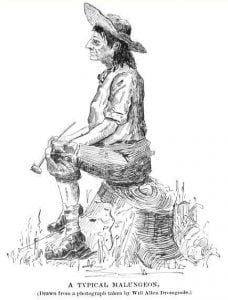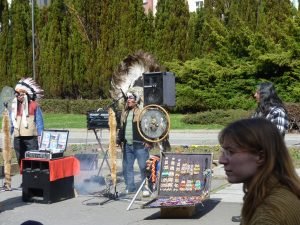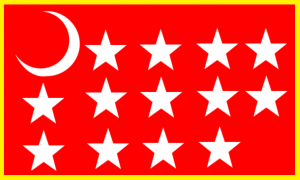The word, Melungeon, dates at least back to the late 1700s and has several interpretations. The most obvious is that it is frontier derivation of the French word, mélange, which means “blend.” Mélangeon would be the proper noun, formed in this word. Beginning in the 1560s many French Huguenots immigrated into the Southeast. It could have been a word that they originally coined. Other scholars believe that the Late Medieval English word, malengin, which means “evil intent,” is the origin. Others believe that the word evolved from the Turkish, malun jinn, which mean “cursed and hidden from sight.” It does not mean “cursed soul” as stated in several references.
The Melungeons were formerly considered to be inferior mongrel forms of Appalachian hillbillies by “proper” white Southerners. Cartoons mocked them. During the late 1700s and 1800s, Melungeons could be classified in the census as being white, Indian or free persons of color. 1 It seems that skin pigment had a great deal to do with the label. In his 1950 doctoral dissertation, cultural geographer Edward Price “proved” that Melungeons were families descended from free people of color and mixed-race unions in colonial Virginia with Native Americans. 2 In actuality, some were. Many had ancestries far more complex than even that.
“The Melungeons are filthy, their home is filthy,” read a report published in the magazine, Arena, in 1891. “They are rogues, natural born rogues, close, suspicious, inhospitable, untruthful, cowardly and, to use their own word, sneaky. In many things they resemble the Negro. . . . They are an unforgiving people, although . . . They are slow to detect an insult, and expect to be spit upon.” 3

The common Melungeon self identity of being Native American may be partially or totally true, but Hollywood has confused the public what a real Native American looks like. The original ancestors of American Indians came from eastern Asia. In other words, they were members of the Mongoloid race. For almost a century, Hollywood used Jewish, Italian, Lebanese and Armenian actors to portray American Indians. The general public came to think that “real” American Indians had Semitic or Anatolian physiques, when, in fact, the indigenous peoples of the Southeast looked much like tall Indonesians.
Mixed heritage families of the Allegheny Mountains and Cumberland Plateau often have these same Semitic or Anatolian facial features and so in the 20th century naturally assumed that they had much more Native American heritage than was generally the case. The U.S. Department of the Interior encouraged that assumption by showing a vast area of the Upper South as always been always occupied by Cherokee Indians. The federal bureaucrats had “forgotten” that early English explorers had encountered Shawnee, Creek and Yuchi Indians, plus Sephardic, African, Turkish or Arabic colonists in the Southern Highlands, but no Cherokees.
It was Dr. Brent Kennedy, an intellectual from southwestern Virginia, who brought awareness of the Melungeons to the national stage. Like most Melungeons of his area, Kennedy assumed that the non-European aspects of his family’s appearance came from “Cherokee” heritage. Also, like most Melungeons, he assumed that some unusual physical traits were peculiar to his extended family. A health crisis in 1988, while Kennedy was living in Atlanta, changed all that. He thought that he had Rocky Mountain Spotted Fever or Lyme Disease, so checked himself into a hospital. 4
Doctors in an Atlanta hospital diagnosed Kennedy with having erythema nodosum sarcoidosis, a disease that is common only to Mediterranean cultures. 5 Kennedy began searching his family’s heritage and soon learned he was descended from Melungeons, not Native Americans. For the next eight years the genealogies of Melungeon families became an obsession with him. Many academicians refused to answer his questions or even communicate with him.

An important exception to this academic ostracism was the University of Tennessee and the state government of Tennessee. 6 Dr. Jefferson Chapman, Director of the Department of Anthropology at the University of Tennessee donated much personal time in obtaining cultural information and helping set up the Melungeon Research Committee. It was originally based at the University of Tennessee, but is now located at the Wise Campus of the University of Virginia. After Kennedy’s health improved, he quit his job in Atlanta as a fund raiser for non-profit organizations and moved back to his home town of Wise, VA.
Kennedy’s independent studies congealed into the publishing of The Melungeons: The Resurrection of a Proud People in 1997. The book included early DNA studies of some Melungeon populations. Kennedy estimated that an original Melungeon population of around 1000-2000 persons in the late 1700s had grown to about 250,000 descendants in the late 20th century. 7 Its most compelling evidence was the collection of 19th century photos of Melungeon people, who clearly looked Turkish, Arabic, Armenian, Egyptian or perhaps Albanian. Kennedy presented a list of Cherokee words that were pronounced almost the same as Turkish words and had the same meaning. The book also included old census tables that showed several prominent Melungeon families had ancestors who the census classified as either Negro or Colored. The genealogies were accompanied by family memories.
The weakest portions of Kennedy’s book dealt with interpretation of family trees and extrapolation of Turkish word meanings and traditions to be equivalent to Native American words and traditions throughout the Southeast, not just the Cherokees. Family tree information is often only a little more than “hearsay.” At the time, Kennedy did not have a strong grasp of Southeastern Native American cultures. For example, the Creek Indians began wearing turbans because of cultural influence from the Mayas over 1500 years ago, not because Middle Eastern people settled in their midst in the 1600s.
Some academicians were virtually rabid in their hostility to the book, and still are. It is still not clear why there was so much opposition to the book from sociologists and historians. The book is primarily a presentation of evidence to support Kennedy’s request for more study on the Melungeons. Sociologists and anthropologists already labeled the Melungeons a “tri-racial isolate group.” Kennedy merely added Iberians, North Africans and Turks to the Heinz 57 mix. Their primary criticism was that Kennedy did not present proof that the Melungeons were anything more than a mixture of English whites with African blacks. They did not consider the many photographs in Kennedy’s book as acceptable evidence.
Whenever a DNA study comes out that claims to prove the English-African interpretation of the Melungeons, a faction of the academic community is ecstatic. 8 When a DNA study is publicized that confirms Kennedy’s theories, there are multiple blogs challenging the qualifications of the DNA lab.
The international attention of Kennedy’s trip to Turkey and subsequent co-authored book, From Anatolia to Appalachia, brought the attention of his Melungeon theories to the Arab world. 9 He was warmly received in Turkey, but Arab extremists viewed him as an agent of the CIA and Israel, who was trying to promote democracy and convert Muslims to Christianity.
Muslim clerics were outraged about Kennedy’s statement that all the Colonial Era Muslim immigrants to North America had converted to Christianity. 10 One of the commands of Islam is that Muslims immigrate to infidel countries where they can eventually take control of the government and convert the population to Islam. Kennedy’s book stated that when Muslims came to America, they converted to Christianity and eventually assimilated into a secular democracy. This “insult to Islam” is the ultimate crime in Islamic tradition and is punished by the death penalty in many predominantly Muslim countries.
Perhaps the clerics over-reacted. Just because an Appalachian immigrant was from the eastern Mediterranean Basin did not mean that he or she was automatically a Muslim. Both Sephardic Jews and Iberian Christians carry similar DNA to Muslim descendants of the Roman Empire around the Mediterranean Basin. 11 Turkey was a bastion of Christianity for 1400 years before it was completely conquered by Islam. Also, Moorish Conversos accompanied early Spanish expeditions. 12
Of the Ottoman’s empire total population of 30 million in 1600 AD, approximately 10-12 million were Christians.There were Christian majorities in most of the Balkan countries, Hungary, Greece, Lebanon, Armenia and Georgia – despite millions of Christians being killed or enslaved in the Ottoman Empire’s 16th century military campaigns. There were large Christian minorities in Egypt, Palestine and Syria.
Furthermore, the Ottoman Empire had a policy of putting a disproportionate number of Christian and Jewish combatants in battles with European powers. The justification was that whether the battle was won or lost, Christians would be killed. Virtually all of the Turkish galley slaves were Christians. 16 These poor souls were the most likely prisoners-of-war, taken by the Spanish to become Spanish galley slaves. All Orthodox and Protestant Christians were treated as “infidels” by the Spaniards.
Armenian extremists accused Kennedy of collaborating with the Turkish government to cover up the Armenian Holocaust. 13 This accusation is based solely on the fact that none of Kennedy’s books mention the Armenian Genocide, while presenting a positive image of the current Turkish Government . During World War I, the Ottoman Empire directly executed or caused the deaths of approximately 2 million Armenian, Greek, Assyrian, Syrian and Lebanese Christians. 14
A more benign faction of Muslims interpreted Kennedy’s book as absolute proof that America had been first “discovered” by Muslim explorers and that many American Indians were the descendants of Muslim colonists. In 2002 the Middle East Policy Council published the Arab World Studies Notebook, a guide for North American teachers for understanding and teaching students about Arab culture. 15 The text claims that Arab explorers came to America many times between 780 and 1492.
The book also claims that it was Moorish explorers who told Columbus about the New World. Of course, on his first two voyages, Columbus thought that he was sailing to China. These Muslims supposedly married Algonquian Indians, whose descendants eventually became tribal chiefs with names like Adbul-Rahim and Abdallah Ibn Malik. Those names cannot be found in conventional historical archives.

More recently, a pamphlet has been published and widely circulated in the Islamic world which states that a Chinese Muslim discovered America and converted the Southeastern Indians to Islam. 16 This pamphlet uses Brent Kennedy’s book as its primary proof. It also states as a fact that the Southeast’s mounds are the ruins of mosques built by faithful Native American Muslims in the 1300s that were destroyed by the early Christian settlers.
As further proof the book cited supposed “crescent and star” motifs on Creek Indian pottery, the crescent and star motif on the South Carolina state flag, the crescent and star on the City of New Orleans seal, and also on the battle flags of Creek and Seminole Confederate regiments in the Civil War.
The Creek and Seminole battle flags were actually derived from the battle flag of the Confederate Army of the West, created by CSA General Earl Van Dorn, a practicing Christian. From 330 AD until 1453 AD a white crescent and star with a red background was the battle flag of the Christian city of Constantinople. It symbolized the assimilation of the Greek world with the star that foretold the birth of Jesus as the Messiah. The conquering Turks modified the flag to have a green background to symbolize that the Ottoman Empire was the legitimate heir of the Roman Empire. In recent centuries many predominately Muslim countries have adopted this ancient Christian symbol as their national symbol also. 17
Racial prejudice still ran strong in some areas of the Appalachians when Kennedy’s book was published. Racists were outraged that Kennedy stated that a sizable percentage of Appalachian mountaineers were descended from Africans or Middle Easterners. His name still provokes hostility among these groups.
Citations:
- Morello, Carol, Beneath Myth, Melungeons Find Roots of Oppression Washington Post, May 30, 2000, p. A10.[↩]
- Price, Edward, Geographical Analysis of White-Negro-Indian Racial Mixtures in the Eastern United States, (Los Angeles State College) Association of American Geographers Annals Vol. 43 (June 1953) pp 138-55.[↩]
- Dromgoole, Will Allen. The Malungeon Tree and Its Four Branches. The Arena, Vol. 3, pp. 745-785. June, 1891.[↩]
- Kennedy, Brent, The Melungeons, The Resurrection of a Proud People, Macon: Mercer University Press, 1997; pp. 1-2.[↩]
- Kennedy, Brent, The Melungeons, The Resurrection of a Proud People, Macon: Mercer University Press, 1997; pp. 1-2.[↩]
- Kennedy, Brent, The Melungeons, The Resurrection of a Proud People, Macon: Mercer University Press, 1997; 107-108.[↩]
- Kennedy, Brent, The Melungeons, The Resurrection of a Proud People, Macon: Mercer University Press, 1997; 103-104.[↩]
- Sassounian, Harut, DNA Study Busts Myth that One Million Appalachians are of Turkish Descent, July 24, 2012.[↩]
- Scolnick, Joseph M. & Kennedy, Brent, From Anatolia to Appalachia, Macon: Mercer University Press, 2003.[↩]
- Personal conversation between Brent Kennedy and author.[↩]
- Roman DNA Project[↩]
- Kennedy, Brent, The Melungeons. May 25, 2003[↩]
- Sassounian, Harut, DNA Study Busts Myth that One Million Appalachians are of Turkish Descent, July 24, 2012.[↩]
- Flynn, John, The Persecution of Christians in Turkey, Catholic Online, 12/23/2009.[↩]
- Native Americans and Islam, MuslimWiki[↩]
- Mroueh, Dr. Youssef, Pre-Columbian Muslims in the Americas, 2012.[↩]
- Kennedy, Brent, The Melungeons, The Resurrection of a Proud People, Macon: Mercer University Press, 1997.[↩]
Discover more from Access Genealogy
Subscribe to get the latest posts sent to your email.
